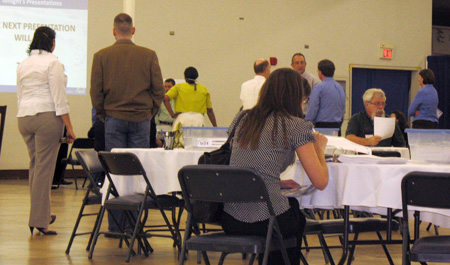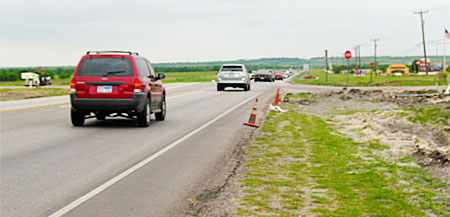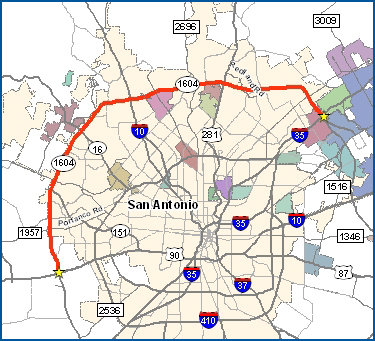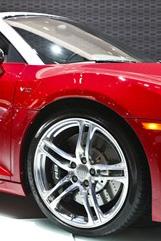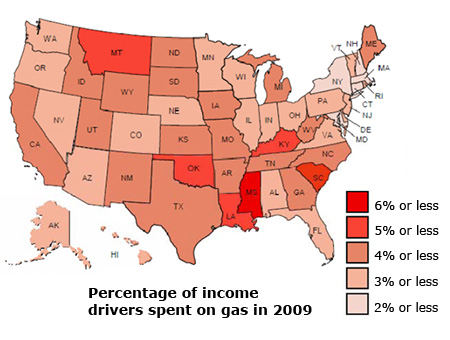Commuting Construction and closures Toll roads Transit: Loop 1604
by Patrick
1 comment
What’s in store for your Loop 1604 commute?
Here’s the gist of what’s being laid out, in a series of public meetings wrapping up tonight, for Loop 1604’s future.
The problem, officials say, is that traffic demand in 25 years will be twice as much as what can fit on the highway today. The lanes can currently handle about 80,000 vehicles a day, but demand is 110,000 now and will surge to 155,000 by 2035.
An environmental study is sizing up impacts of three basic strategies:
Buses and passenger rail. At best, this can meet 15 percent of demand when you consider that top-notch transit cities such as San Francisco, Washington and Boston snare about that much of the trips in those cities.
Managing and improving traffic flows. This is done with engineering, like the super street idea, and behavior incentives that range from carpooling to staggered work hours and telecommuting. California enacted laws requiring large employers to use such commuting strategies but cut traffic just 3 percent.
Adding four lanes to the highway. Since each lane can handle about 20,000 vehicles a day, that would do the trick.
So you can see where the math leads.
However, a dozen various community criteria will also drive decisions, and that produces a little more mix into the approaches.
Commuting Construction and closures: Loop 1604 stimulus funds
by Patrick
Comments Off on Loop 1604 getting a helping of stimulus
Loop 1604 getting a helping of stimulus
Workers began plopping orange cones into place along Loop 1604 near Randolph AFB and driving in heavy machinery last week.
The job is to widen the road into a four-lane divided highway from FM 78 to Graytown Road by summer 2011, according to the Texas Department of Transportation. Federal stimulus dollars are funding the $6.63 million cost.
“These improvements have been in the works for several years but were unfunded,” TxDOT engineer Frank Holzmann said in a statement. “With availability of economic stimulus funding, we now have an opportunity to move forward on this.”
But moving forward could be a slow and/or muddy affair for now. The National Weather Service has forecast rain throughout the week.
Three, two, one… liftoff!
For a long time, my wife and I have wanted to see the launch of a Space Shuttle. With the Shuttle program winding-down this year, we realized a couple of months ago that it was do-or-die time, so a little over a week ago, we packed-up our 18-month-old and headed down to Florida to see the April 5th launch, what is likely to be the last nighttime launch of a Space Shuttle. And wow, am I glad we did.
Where do bad driving habits come from?
I don’t have a good answer for this question but I do wonder where bad driving habits come from. I was compelled to think about this after I was almost impelled over the side of the remarkably high bridge connecting IH10 and Loop 410 on Sunday morning by an oblivious young woman concentrating on texting, who may not even have noticed what happened.
I suspect such insanity creeps up on you. You try something once in a relatively safe environment and then the foolishness takes on a life of its own. I dare say I am not a paragon of virtue, either. Anyhoo, what kind of witless driving are you seeing and what do you think is going through the minds of the perpetrators?
Massive Loop 1604 study goes back to the public
The top ideas on how to add lanes to almost half of Loop 1604 will be laid out in a series of three public meetings this week so officials can get input.
With gas taxes strangled by decades of inflation, diversions and political inaction, toll fees and toll-backed bonds have emerged as a primary path to get some things done on the 37-mile stretch of highway.
A previous study was derailed in 2008 after toll opponents and environmental activists filed a lawsuit in a federal court. The lawsuit in part called for Loop 1604 and U.S. 281 to be studied together, since they would have been part of an interrelated tollway system, and the judge seemed to agree.
For this week’s meetings, study officials will provide several short presentations each night, from 6 to 8:30 p.m.:
- Monday, Valero Headquarters, Building D, One Valero Way.
- Tuesday, Live Oak Civic Center, Main Hall, 8101 Pat Booker Rd.
- Wednesday, Vale Middle School, cafeteria, 2120 N. Ellison Dr.
For more information or help, start out at More for 1604’s event page.
Other links:
Automobiles Commuting Uncategorized
by Patrick
Comments Off on Top-rated cars for working people
Top-rated cars for working people
The New York International Auto Show has been offering up plenty of glam and muscle to hog the spotlight since last week.
MSN has had fun giving us the show’s 10 most notable unveils, and the 10 sexiest rides — i.e., to your right is a glimpse of the Audi R8 Spyder (go ahead, click the glitz for a full view).
“Give us sports cars and make them sexy as hell,” MSN’s Matthew de Paula declared. “We want 10-mile-per-gallon Lamborghini Gallardos and 510-horsepower Aston Martins all the way.”
Closer to ground level, Consumer Reports plodded forward to give us the New York standouts. Cars.com patiently poked and prodded the show’s winners and losers.
It’s a lot to digest, sort of like trying to eat your way into a bargain at an all-you-can eat buffet.
I guess that’s why my thoughts keep drifting back to a more meat-and-potatoes Top Picks announced just before the noise revved up in New York. Using affordability, comfort and safety as criteria, AAA selected the best cars to commute to work in.
And topping AAA’s list is the …
WTF? Oh, it’s a FYA!

“What the heck is that?!”
That seems to be a common reaction of local motorists as they first encounter one of the flashing yellow arrow (FYA) traffic signals that have popped-up at San Antonio intersections over the past year or so. What began as an experiment in late 2008 at a couple dozen intersections along Wurzbach Rd. and San Pedro Ave. has now spread to about 40 or so intersections across the city and will now become a standard, not just here in San Antonio, but nationally as mandated by the federal Manual on Uniform Traffic Control Devices (MUTCD). As often happens in these cases, there has been some second-guessing amongst the general public as to the necessity of this newfangled signal, but understanding the research that went into it and why it’s beneficial generally allays those knee-jerk criticisms.
Tragedy provides reminders
It’s been over two weeks now since the accident that killed Rosita Davila. According to reports, off-duty SAPD officer Gabe Trevino was entering Loop 1604 westbound near Stone Oak after midnight that night and collided with a car being driven by Davila, causing her car to skid off the roadway and flip over the center barrier, killing her and injuring a passenger.
This tragedy serves as a tragic reminder of two important traffic laws, both of which have been a focus of the initial investigation. Firstly, drivers entering a freeway must yield to traffic already on the freeway. Inexplicably, I’ll get an e-mail from time-to-time from someone who firmly believes that traffic entering the freeway has the right-of-way unless there’s a yield sign (which is fairly rare.) However, traffic entering a freeway is considered to be changing lanes, and you must always yield to traffic already in a lane into which you’re merging.
Secondly, all drivers have a fundamental duty to do everything they reasonably can to avoid an accident. I can’t count how many times I’ve seen drivers forcibly assert their right-of-way and nearly cause an accident. Please understand that I’m not saying that’s what happened in this case, but the initial accident report did proffer that as a possible cause, and even if it’s moot, it still offers a reminder that’s it’s entirely possible to be “dead right.”
It has recently been reported that Trevino was texting or otherwise using his cell phone at the time of the accident. The dangers of this are obvious, and again, this case offers yet another reminder. If not, take a look at the new AT&T ads about texting while driving:
http://fastlane.dot.gov/2010/03/new-antitexting-campaign-breaks-hearts-and-unsafe-habits.html
Texans pay a lot for gas
I admit, I don’t know exactly how much I pay for gas every year. I bet most people don’t. But we should, because it’s a lot.
Average Texas drivers paid $1,819 for gas last year, chewing up 4.9 percent of their incomes, according to numbers crunched by the National Resources Defense Council.
Texas ranked seventh among states for percent of incomes spent on gas. Mississippi was first with 6.2 percent, while Connecticut was last with just 2.5 percent.
Remember, though, regular-grade gas last year was 90 cents a gallon cheaper than in 2008, when prices careened to $4 a gallon. Thus, the point of this NRDC white paper: What would happen if prices, which are steadily rising, spiked again?
For Texans, the answer is gas bills 80 percent higher — or 8.7 percent of incomes. If the next spike turns into a steep plateau, the bill over a year would average $3,264.
Links:
